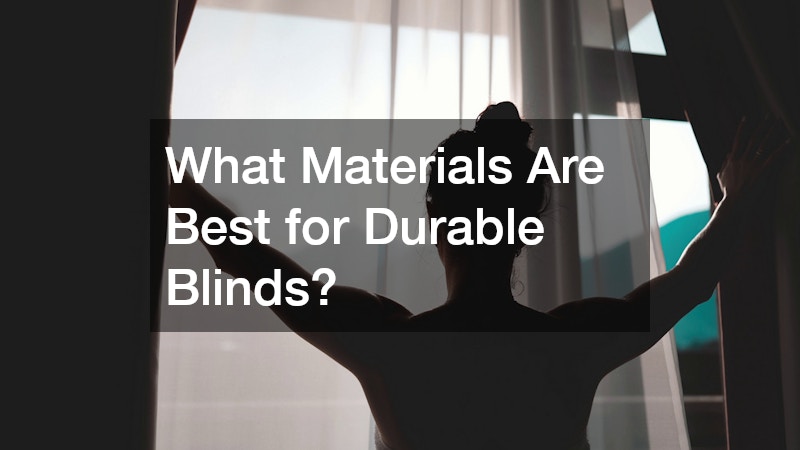Choosing the right materials for blinds can significantly influence their longevity, function and aesthetic appeal. Whether you are outfitting a modern city apartment or a heritage-style home, understanding the most durable blind materials ensures that your investment lasts while providing optimal light control and privacy. With the Australian climate offering a unique blend of scorching summers, salty coastal air and occasional storms, durability is not just a preference—it’s a necessity.
Understanding Durability in the Australian Context
Durability in window furnishings is not solely about withstanding wear and tear over time. In Australia, it also refers to resistance against UV damage, moisture, fading, warping and even mould. Many homeowners overlook the impact of direct sun exposure and humidity on interior materials. When it comes to blinds, using the right material can mean the difference between blinds that last a decade and those that degrade in just a few short years. Therefore, material choice should be carefully matched to the specific conditions of the room—be it a sun-drenched lounge, a damp bathroom or a steamy kitchen.
Timber & Faux Wood: Natural Appeal Meets Functionality
Timber blinds are often favoured for their timeless beauty and natural warmth. Made from hardwoods like basswood or cedar, these blinds are sturdy and provide excellent insulation. However, real wood can be vulnerable to moisture, making it less ideal for humid areas unless properly treated. In contrast, faux wood blinds offer a similar appearance but are manufactured from PVC or composite materials. These alternatives mimic the texture of natural timber while being more resistant to moisture and warping. For households near the coast or with high indoor humidity, faux wood blinds provide the aesthetic of timber without the maintenance issues.
Aluminium: Sleek, Strong & Lightweight
Aluminium remains one of the most durable materials for blinds, especially in commercial settings or contemporary homes. These blinds are highly resistant to rust, warping and UV degradation. They are lightweight yet strong, making them ideal for wide windows. Aluminium blinds are also easy to clean, which is particularly useful in dusty or allergen-prone environments. Their sleek appearance suits minimalist interiors, and the wide range of available finishes and colours allows them to seamlessly blend into any design scheme.
PVC and Vinyl: Affordable & Resilient
Polyvinyl chloride (PVC) and vinyl materials are commonly used for vertical and roller blinds due to their affordability and versatility. These materials are highly durable in wet environments, making them perfect for bathrooms, laundries and kitchens. They resist mould, cracking and fading, even with constant exposure to sunlight and moisture. While they may lack the luxurious appeal of natural materials, modern designs offer a more refined appearance, allowing homeowners to enjoy the practical benefits without compromising too much on aesthetics.
Fabric Blinds: Softness with Reinforcement
Fabric blinds, such as Roman or roller style, provide a softer, more elegant touch to interiors. However, durability varies depending on the fabric used. Polyester and acrylic blends tend to be more robust and stain-resistant compared to natural fibres like cotton or linen. Many fabric blinds now include UV-resistant coatings or are blended with synthetic fibres to improve their resistance to sun damage and moisture. In high-traffic areas or homes with children and pets, choosing treated fabrics can make a significant difference in maintaining the blinds’ appearance over time.
Composite Materials: The Best of Both Worlds
Advancements in manufacturing have led to the development of composite materials that combine natural and synthetic elements to enhance durability. These hybrid materials offer strength, moisture resistance and aesthetic appeal, often outperforming traditional materials in extreme environments. For instance, some composite blinds use a mix of engineered wood and polymer for added resilience. These materials are particularly effective in spaces that demand both beauty and practicality, such as open-plan living areas with large glass panels.
Energy Efficiency & Insulation Properties
While durability is a primary concern, it is also worth considering how the chosen material contributes to energy efficiency. In Australia’s climate, blinds can play a critical role in regulating indoor temperatures. Timber and fabric materials tend to offer better insulation properties, helping to retain warmth during winter and block heat during summer. Reflective coatings on PVC or aluminium blinds can also help deflect solar heat, reducing reliance on air conditioning and contributing to lower energy costs over time.
Choosing Based on Room Function & Exposure
Each room in a home or commercial space presents unique challenges, and the best material for blinds will often depend on location and function. Bedrooms may benefit from insulated fabric blinds that enhance sleep quality, while kitchens and bathrooms demand materials like aluminium or PVC for their resistance to grease and moisture. For outdoor or semi-outdoor areas, such as patios or sunrooms, only weather-resistant materials like treated aluminium or UV-stabilised PVC should be considered.
Investing in high-quality materials for your blinds ensures they will endure the test of time and the Australian elements. Whether you prioritise style, functionality, or cost-effectiveness, there is a suitable material for every need. From the sleek toughness of aluminium to the soft resilience of treated fabrics, each option brings distinct advantages. By aligning material choice with room function, environmental conditions and aesthetic preferences, you can enjoy the long-term benefits of blinds that are not only durable but also enhance the overall comfort and beauty of your space.

